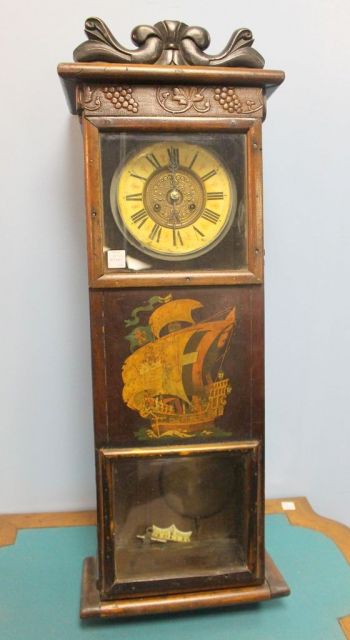Encyclopedia of Antiques
Clocks
 Hourglasses were used centuries ago as indicators of time. Progress has been from the hourglass to a water clock, time lamp, the 13th Century invention which had a balance and one hand (the minute hand was added along with the pendulum in the 17th Century), the spiral spring clock, and the one run by weights.
Hourglasses were used centuries ago as indicators of time. Progress has been from the hourglass to a water clock, time lamp, the 13th Century invention which had a balance and one hand (the minute hand was added along with the pendulum in the 17th Century), the spiral spring clock, and the one run by weights.The “wag-on-the-wall” clock was named such because of the long pendulum that hung below the clock works. The enclosure of the “wag-on-the-wall” gave us the grandfather clock. There were many different kinds of grandfather clocks; the cases were of various woods—mahogany, walnut, cherry, and pine. Some were very plain, while others were quite ornate. Smaller clocks of the same basic structure are called grandmother clocks.
Clock works were of metal or wood. Actually, those with wood works are of less value, because they were less costly to manufacture.
The banjo clock, so named because of its shape, was invented by Simon Willard of Roxbury, Massachusetts, in 1801. Shaped similar to the musical instrument, the circular body contains the dial and the long neck ends in a box of rectangular shape which houses the pendulum. Glass which framed the lower parts was painted in reverse primarily to hide the pendulum. In 1814 Eli Terry of Plymouth, Connecticut, made a popular-priced mantel clock called the pillar and scroll. It ran for thirty hours and was made with both wood and brass works. Many other shelf clocks were introduced at this time—early Nineteenth Century. A very familiar mantel (or shelf, as some prefer) clock was the steeple clock.
Dials ranged from the fancy engraved ones of the seventeenth century to the enameled ones of the eighteenth and nineteenth centuries. Dials vary in numerals also—Arabic or Roman.
Clock hands ranged from the plain arrowhead to the more elaborate types with open loops. The most involved were often put on the finer clocks and understandably so, because one pair of hands took one man four weeks to produce.
Added by: EdensAuctions
Add content for this subject

